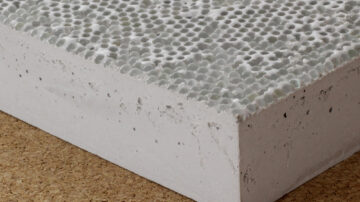Ultra-High Performance Concrete (UHPC) is a cementitious, concrete material that has a minimum specified compressive strength of 17,000 pounds per square inch (120 MPa) with specified durability, tensile ductility and toughness requirements; fibers are generally included in the mixture to achieve specified requirements.Ultra-High Performance Concrete (UHPC), is also known as reactive powder concrete (RPC). The material is typically formulated by combining portland cement, supplementary cementitious materials, reactive powders, limestone and or quartz flour, fine sand, high-range water reducers, and water. The material can be formulated to provide compressive strengths in excess of 29,000 pounds per square inch (psi) (200 MPa). The use of fine materials for the matrix also provides a dense, smooth surface valued for its aesthetics and ability to closely transfer form details to the hardened surface. When combined with metal, synthetic or organic fibers it can achieve flexural strengths up to 7,000 psi (48 MPa) or greater.
Fiber types often used in UHPC include high carbon steel, PVA, Glass, Carbon or a combination of these types or others. The ductile behavior of this material is a first for concrete, with the capacity to deform and support flexural and tensile loads, even after initial cracking. The high compressive and tensile properties of UHPC also facilitate a high bond strength allowing shorter length of rebar embedment in applications such as closure pours between precast elements.
UHPC construction is simplified by eliminating the need for reinforcing steel in some applications and the materials high flow characteristics that make it self-compacting. The UHPC matrix is very dense and has a minimal disconnected pore structure resulting in low permeability (Chloride ion diffusion less than 0.02 x 10-12 m2/s. The material’s low permeability prevents the ingress of harmful materials such as chlorides which yields superior durability characteristics.
Some manufacturers have created just-add-water UHPC pre-mixed products that are making UHPC products more accessible. The American Society for Testing and Materials has established ASTM C1856/1856M Standard Practice for Fabricating and Testing Specimens of Ultra High Performance Concrete that relies on current ASTM test methods with modifications to make it suitable for UHPC. The following is an example of the range of material characteristics for UHPC:
StrengthCompressive: 17,000 to 22,000 psi, (120 to 150 MPa)Flexural: 2200 to 3600 psi, (15 to 25 MPa) Modulus of Elasticity: 6500 to 7300 ksi, (45 to 50 GPa) DurabilityFreeze/thaw (after 300 cycles): 100%Salt-scaling (loss of residue): < 0.013 lb/ft3, (< 60 g/m2) Abrasion (relative volume loss index): 1.7 Oxygen permeability: < 10-19 ft2, (<10-20 m2)
The introduction of UHPC in the industry has been a new trend. UHPC is popularly known as the new concrete technology. It contains numerous novel ingredients specifically the fibers but still retaining 80 % of the overall traditional concrete. The fibers often differ in strength when it comes to stainless steel and polyester. Fibers used are capable of delivering additional durability and strength specifically to the end products. UHPC tends to have a longer life of usefulness in comparison with the traditional concrete. Approximately, it has more than 75 years of usefulness whilst the traditional concrete normally has 15-25 years. The comprehensive strength is also determined and considered and other additional benefits of UHPC include remarkable resistance to environmental degradation as well as moisture penetration. There’s also great resistance to ductility and adhesiveness.
Below are other major qualities of UHPC apart from the mentioned above:
Freeze/thaw resistance– after 600 freeze/ thaw cycles, UHPC is expectedly 100% exhibited of its substantial properties
Abrasion resistance– UHPC strongly demonstrates excellent abrasion resistance twice as much as normal concrete’s resistance.
Chloride permeability– UHPC amazingly showed greatly migration of low chloride when being tested compare with the normal concrete having less than 10%
UHPC is basically known as the first being used for bridge construction. Here is a long list of “bridge applications” for UHPC:
>Field-cast closure
>Bridge decks and its thin bonded overlays
>Precast concrete piles
>Security and applications for blast mitigation
>Pre-stressed girders
First Use of Ultra-High Performance Concrete for an Innovative Train Station Canopy
The Shawnessy Light Rail Transit (LRT) Station, constructed during fall 2003 and winter 2004, forms part of a southern expansion to Calgary’s LRT system and is the world’s first LRT system to be constructed with ultra-high performance concrete (UHPC). The innovative project, designed by Enzo Vicenzino of CPV Group Architects Ltd., is owned by the City of Calgary, managed by the Transportation Project Office (TPO), and constructed by general contractor, Walter Construction.

Leave a Reply
You must be logged in to post a comment.